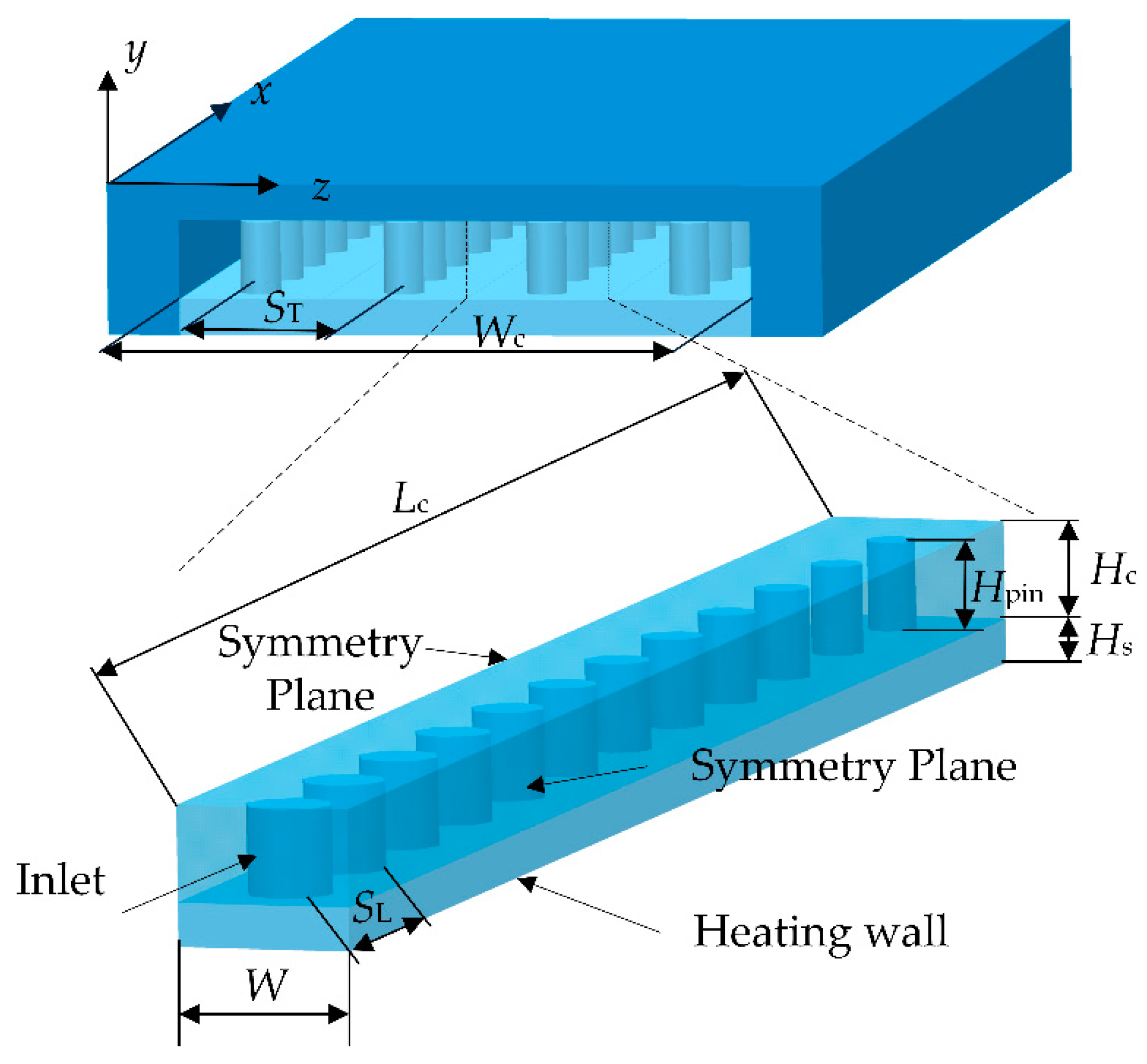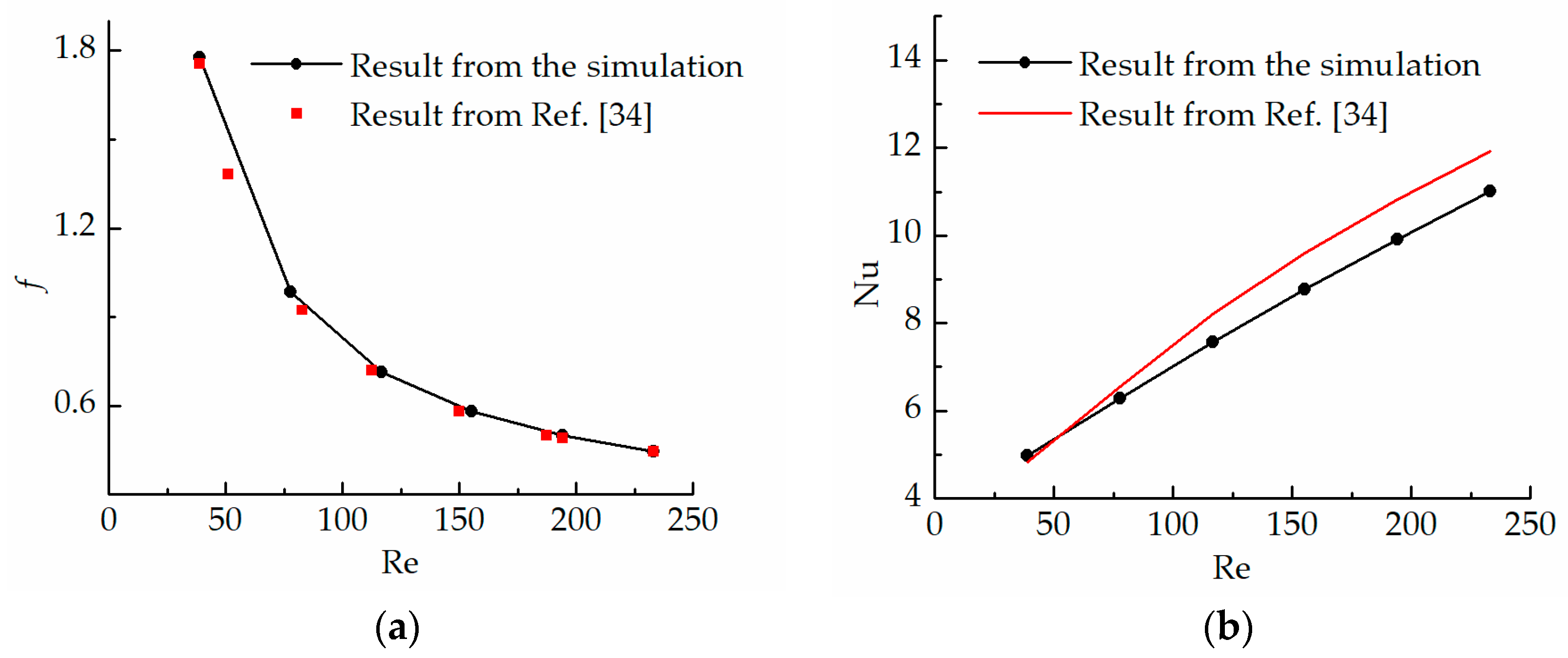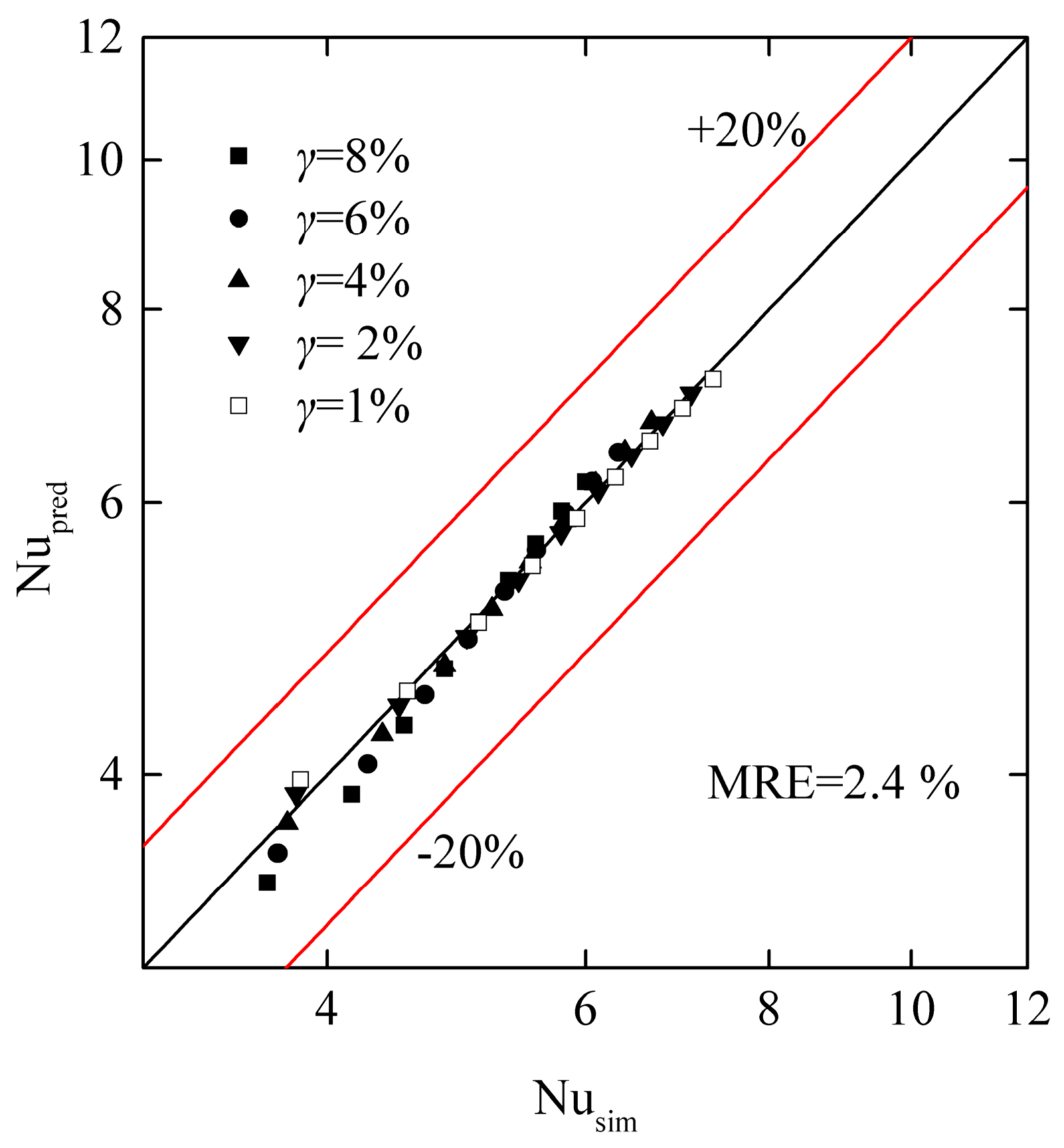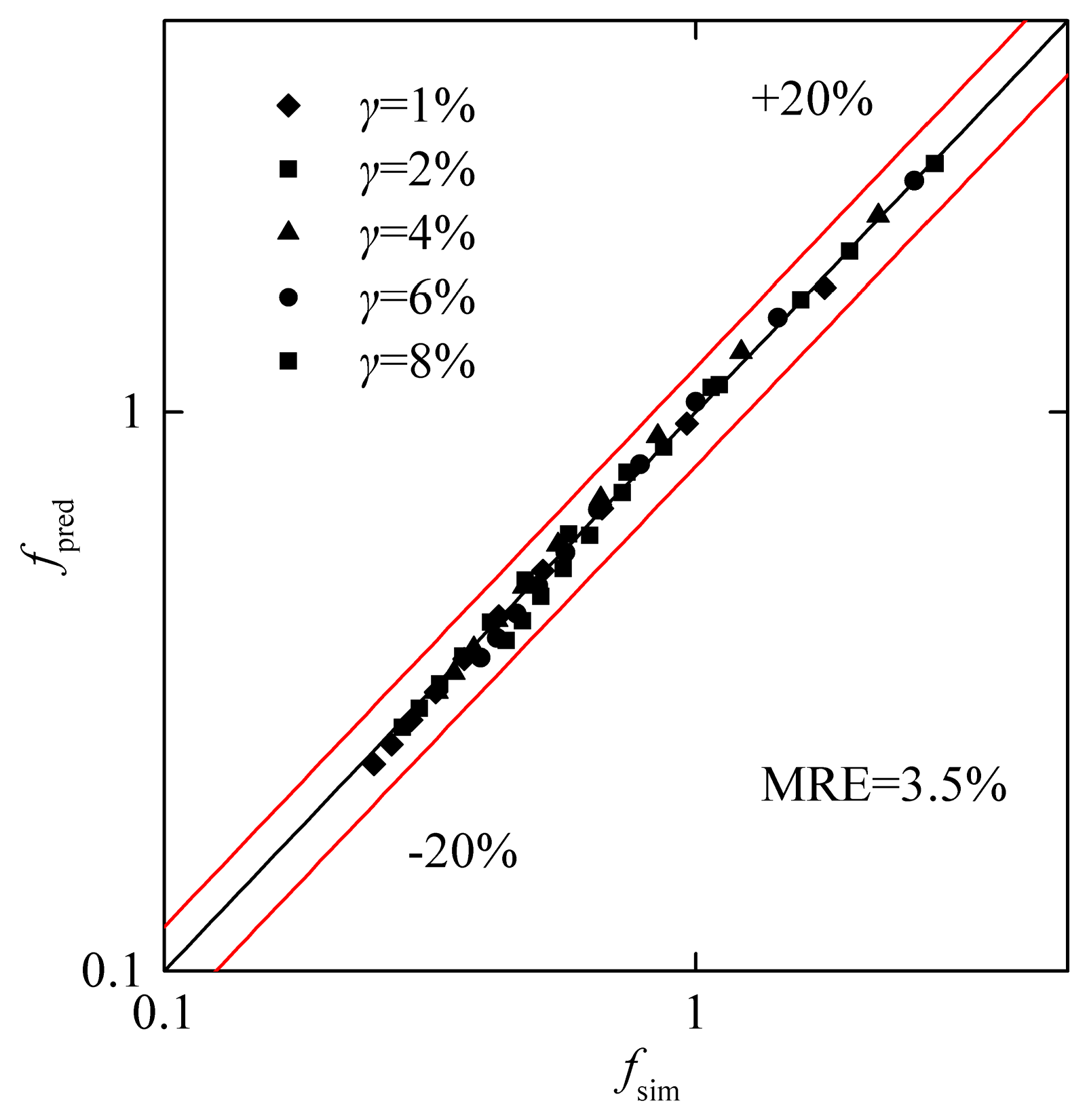Effect of Pin Diameter Degressive Gradient on Heat Transfer in a Microreactor with Non-Uniform Pin-Fin Array under Low Reynolds Number Conditions
Abstract
:1. Introduction
2. Mathematical Modeling
2.1. Computation Domain
2.2. Mathematical Modeling
2.3. Numerical Methods
3. Results and Discussion
3.1. Validation
3.2. Influence of Pin Diameter Degressive Gradient
3.3. New Heat Transfer Correlation for NPFA
3.4. New Friction Factor Correlation for NPFA
4. Conclusions
- (1)
- The Nu and f at a low Re were sensitive to the pin diameter degressive gradient. With an increase of the pin diameter degressive gradient, the f and Nu decreased.
- (2)
- To guide the optimization of the pin diameter degressive gradient for the NPFA, a new heat transfer correlation was developed in this paper. The exponent of (1 – γ) for the Nusselt number was 2.1, indicating that the pin diameter degressive gradient had an impact on the heat transfer characteristics of the NPFA. MRENu was calculated to be 2.4%, indicating that the new heat transfer correlation adequately predicted the Nusselt number of the NPFA with various pin diameter degressive gradients.
- (3)
- A new friction factor correlation was developed in this paper to account for the effect of the pin diameter degressive gradient. The exponent of (1 – γ) for the friction factor was 6.9, indicating the significant influence of the pin diameter degressive gradient on the pressure drop characteristics of the NPFA. MREf was calculated to be 3.5%, showing the feasibility of the improved friction factor correlation to predict the f of the NPFA with various pin diameter degressive gradients.
Author Contributions
Funding
Conflicts of Interest
Nomenclature
| Amin | the minimum transverse section area of the channel: m2 |
| cp | specific heat, J/(kg K) |
| Dpin | diameter of pin, mm |
| f | friction factor |
| have | heat transfer coefficient, W/(m2 K) |
| Hc | channel height, mm |
| Hpin | pin height, mm |
| Hs | solid thickness, mm |
| kf | thermal conductivity of fluid, W/(m K) |
| ks | thermal conductivity of solid, W/(m K) |
| Lc | channel length, mm |
| M | the number of data points |
| NL | the number of pin-fin along the lengthwise direction |
| NT | the number of pin-fin along the transverse direction |
| Nu | average Nusselt number |
| p | flow pressure, Pa |
| Pr | Prandtl number |
| q | heat flux, W/m2 |
| Qf | inlet flow rate, m3/s |
| Re | Reynolds number |
| SL | longitudinal center distance between two pins, mm |
| ST | transverse center distance between two pins, mm |
| Tf | the fluid temperature, K |
| Ts | the solid temperature, K |
| Tw | wall temperature, K |
| W | the symmetric channel width, mm |
| Wc | channel width of microreactor, mm |
| Greek symbols | |
| υr | relative flow dynamic viscosity, υout/υin |
| γ | pin diameter degressive gradient |
| μf | flow viscosity, Pa s |
| ρf | fluid density, kg/m3 |
References
- Peighambardoust, S.J.; Rowshanzamir, S.; Amjadi, M. Review of the proton exchange membranes for fuel cell applications. Int. J. Hydrogen Energy 2010, 35, 9349–9384. [Google Scholar] [CrossRef]
- AbouOmar, M.S.; Zhang, H.J.; Su, Y.X. Fractional order fuzzy pid control of automotive pem fuel cell air feed system using neural network optimization algorithm. Energies 2019, 12, 1435. [Google Scholar] [CrossRef]
- Yu, L.J.; Ren, G.P.; Qin, M.J.; Jiang, X.M. Simulation of performance influencing factors of proton exchange membrane fuel cells in different flow modes. Eng. Appl. Comput. Fluid Mech. 2008, 2, 344–353. [Google Scholar] [CrossRef]
- Holladay, J.D.; Hu, J.; King, D.L.; Wang, Y. An overview of hydrogen production technologies. Catal. Today 2009, 139, 244–260. [Google Scholar] [CrossRef]
- Navarro, R.M.; Sanchez-Sanchez, M.C.; Alvarez-Galvan, M.C.; Valle, F.D.; Fierro, J.L.G. Hydrogen production from renewable sources: Biomass and photocatalytic opportunities. Energy Environ. Sci. 2009, 2, 35–54. [Google Scholar] [CrossRef]
- Aartun, I.; Silberova, B.; Venvik, H.; Pfeifer, P.; Gorke, O.; Schubert, K.; Holmen, A. Hydrogen production from propane in rh-impregnated metallic microchannel reactors and alumina foams. Catal. Today 2005, 105, 469–478. [Google Scholar] [CrossRef]
- Resnik, D.; Hocevar, S.; Batista, J.; Vrtacnik, D.; Mozek, M.; Amon, S. Si based methanol catalytic micro combustor for integrated steam reformer applications. Sens. Actuators A Phys. 2012, 180, 127–136. [Google Scholar] [CrossRef]
- Sohn, J.M.; Chang Byun, Y.; Yeon Cho, J.; Choe, J.; Ho Song, K. Development of the integrated methanol fuel processor using micro-channel patterned devices and its performance for steam reforming of methanol. Int. J. Hydrogen Energy 2007, 32, 5103–5108. [Google Scholar] [CrossRef]
- Mei, D.Q.; Liang, L.W.; Qian, M.; Feng, Y.B. A performance study of methanol steam reforming in an a-type microchannel reactor. Int. J. Hydrogen Energy 2014, 39, 17690–17701. [Google Scholar] [CrossRef]
- Jang, J.Y.; Cheng, C.H.; Huang, Y.X.; Lee, C.I.; Leu, C.H. Optimal design of parallel channel patterns in a micro methanol steam reformer. Int. J. Hydrogen Energy 2012, 37, 16974–16985. [Google Scholar] [CrossRef]
- Zhou, W.; Deng, W.; Lu, L.; Zhang, J.; Qin, L.; Ma, S.; Tang, Y. Laser micro-milling of microchannel on copper sheet as catalyst support used in microreactor for hydrogen production. Int. J. Hydrogen Energy 2014, 39, 4884–4894. [Google Scholar] [CrossRef]
- Hsueh, C.Y.; Chu, H.S.; Yan, W.M.; Chen, C.H. Transport phenomena and performance of a plate methanol steam micro-reformer with serpentine flow field design. Appl. Energy 2010, 87, 3137–3147. [Google Scholar] [CrossRef]
- Yao, F.; Chen, Y.; Peterson, G.P. Hydrogen production by methanol steam reforming in a disc microreactor with tree-shaped flow architectures. Int. J. Heat Mass Transf. 2013, 64, 418–425. [Google Scholar] [CrossRef]
- Pan, M.Q.; Tang, Y.; Wei, X.L.; Jiang, X. Oriented linear cutting fiber sintered felt as an innovative catalyst support for methanol steam reforming. Int. J. Hydrogen Energy 2011, 36, 7066–7073. [Google Scholar] [CrossRef]
- Pan, M.Q.; Wei, X.L.; Tang, Y. Factors influencing methanol steam reforming inside the oriented linear copper fiber sintered felt. Int. J. Hydrogen Energy 2012, 37, 11157–11166. [Google Scholar] [CrossRef]
- Mei, D.Q.; Qian, M.; Liu, B.H.; Jin, B.; Yao, Z.H.; Chen, Z.C. A micro-reactor with micro-pin-fin arrays for hydrogen production via methanol steam reforming. J. Power Sources 2012, 205, 367–376. [Google Scholar] [CrossRef]
- Mei, D.Q.; Qian, M.; Yao, Z.H.; Liu, B.H.; Lou, X.Y.; Chen, Z.C. Effects of structural parameters on the performance of a micro-reactor with micro-pin-fin arrays (MPFAR) for hydrogen production. Int. J. Hydrogen Energy 2012, 37, 17817–17827. [Google Scholar] [CrossRef]
- Hao, Y.Z.; Du, X.Z.; Yang, L.J.; Shen, Y.Q.; Yang, Y.P. Numerical simulation of configuration and catalyst-layer effects on micro-channel steam reforming of methanol. Int. J. Hydrogen Energy 2011, 36, 15611–15621. [Google Scholar] [CrossRef]
- Zhou, W.; Wang, Q.; Li, J.; Tang, Y.; Huang, Z.; Zhang, J.; Lu, Q. Hydrogen production from methanol steam reforming using porous copper fiber sintered felt with gradient porosity. Int. J. Hydrogen Energy 2015, 40, 244–255. [Google Scholar] [CrossRef]
- Qian, M.; Mei, D.Q.; Yi, Z.D.Y.; Feng, Y.B.; Chen, Z.C. Fluid flow and heat transfer performance in a micro-reactor with non-uniform micro-pin-fin arrays for hydrogen production at low Reynolds number. Int. J. Hydrogen Energy 2017, 42, 553–561. [Google Scholar] [CrossRef]
- Short, B.E.; Price, D.C.; Raad, P.E. Performance of pin fin cast aluminum coldwalls, part 1: Friction factor correlations. J. Thermophys. Heat Transf. 2002, 16, 389–396. [Google Scholar] [CrossRef]
- Short, B.E.; Raad, P.E.; Price, D.C. Performance of pin fin cast aluminum coldwalls, part 2: Colburn j-factor correlations. J. Thermophys. Heat Transf. 2002, 16, 397–403. [Google Scholar] [CrossRef]
- Armstrong, J.; Winstanley, D. A review of staggered array pin fin heat transfer for turbine cooling applications. J. Turbomach. 1988, 110, 94–103. [Google Scholar] [CrossRef]
- Hwang, T.H.; Yao, S.C. Crossflow heat transfer in tube bundles at low reynolds numbers. J. Heat Transf. 1986, 108, 697–700. [Google Scholar] [CrossRef]
- Zukauskas, A. Heat transfer from tubes in crossflow. Adv. Heat Transf. 1972, 8, 93–160. [Google Scholar]
- Huang, L.; Li, Q.; Zhai, H. Experimental study of heat transfer performance of a tube with different shaped pin fins. Appl. Therm. Eng. 2018, 129, 1325–1332. [Google Scholar] [CrossRef]
- Chyu, M. Heat transfer and pressure drop for short pin-fin arrays with pin-endwall fillet. J. Heat Transf. 1990, 112, 926–932. [Google Scholar] [CrossRef]
- Hwang, J.J.; Lai, D.Y.; Tsia, Y.P. Heat transfer and pressure drop in pin-fin trapezoidal ducts. J. Turbomach. 1999, 121, 264–271. [Google Scholar] [CrossRef]
- Qu, W.L.; Siu-Ho, A. Liquid single-phase flow in an array of micro-pin-fins—Part I: Heat transfer characteristics. J. Heat Transf. 2008, 130. [Google Scholar] [CrossRef]
- Qu, W.L.; Siu-Ho, A. Liquid single-phase flow in an array of micro-pin-fins—Part II: Pressure drop characteristics. J. Heat Transf. 2008, 130. [Google Scholar] [CrossRef]
- Mita, J.; Qu, W. Pressure drop of water flow across a micro-pin–fin array part 1: Isothermal liquid single-phase flow. Int. J. Heat Mass Tranf. 2015, 89, 1073–1082. [Google Scholar] [CrossRef]
- Moores, K.A.; Joshi, Y.K. Effect of tip clearance on the thermal and hydrodynamic performance of a shrouded pin fin array. J. Heat Transf. 2003, 125, 999–1006. [Google Scholar] [CrossRef]
- Moores, K.A.; Kim, J.; Joshi, Y.K. Heat transfer and fluid flow in shrouded pin fin arrays with and without tip clearance. Int. J. Heat Mass Transf. 2009, 52, 5978–5989. [Google Scholar] [CrossRef]
- Mei, D.Q.; Lou, X.Y.; Qian, M.; Yao, Z.H.; Liang, L.W.; Chen, Z.C. Effect of tip clearance on the heat transfer and pressure drop performance in the micro-reactor with micro-pin-fin arrays at low reynolds number. Int. J. Heat Mass Transf. 2014, 70, 709–718. [Google Scholar] [CrossRef]
- Tullius, J.F.; Tullius, T.K.; Bayazitoglu, Y. Optimization of short micro pin fins in minichannels. Int. J. Heat Mass Transf. 2012, 55, 3921–3932. [Google Scholar] [CrossRef]
- Arjun, K.S.; Kumar, R. Optimization of micro pin-fin heat sink with staggered arrangement. Therm. Sci. 2018, 22, 2919–2931. [Google Scholar] [CrossRef]
- Xia, G.D.; Jiang, J.; Wang, J.; Zhai, Y.L.; Ma, D.D. Effects of different geometric structures on fluid flow and heat transfer performance in microchannel heat sinks. Int. J. Heat Mass Transf. 2015, 80, 439–447. [Google Scholar] [CrossRef]
- Smith, F.T. A structure for laminar-flow past a bluff body at high reynolds-number. J. Fluid Mech. 1985, 155, 175–191. [Google Scholar] [CrossRef]
- Prasher, R.S.; Dirner, J.; Chang, J.Y.; Myers, A.; Chau, D.; He, D.M.; Prstic, S. Nusselt number and friction factor of staggered arrays of low aspect ratio micropin-fins under cross flow for water as fluid. J. Heat Transf. 2007, 129, 141–153. [Google Scholar] [CrossRef]






| Change Rate of Pin Diameter γ, % | 1, 2, 4, 6, 8 |
|---|---|
| Diameter for the first pin Dpin, mm | 1 |
| Pin height Hpin, mm | 1 |
| Channel length Lc, mm | 29 |
| Symmetric channel width W, mm | 2 |
| Channel height Hc, mm | 1.1 |
| Hc/Hpin, | 1.1 |
| Hs, mm | 0.5 |
| SL, mm | 2 |
| ST, mm | 2 |
| Pin-fin number along the lengthwise direction NL | 12 |
| Tair, K | cp, J/(kg K) | kf × 102, W/(m K) | μf × 106, Pa s |
|---|---|---|---|
| 293.15 | 1005 | 2.59 | 18.1 |
| 313.15 | 1005 | 2.76 | 19.1 |
| 333.15 | 1005 | 2.9 | 20.1 |
| 353.15 | 1009 | 3.05 | 21.1 |
| 373.15 | 1009 | 3.21 | 21.9 |
| 413.15 | 1013 | 3.49 | 23.7 |
| 453.15 | 1022 | 3.78 | 25.3 |
| 523.15 | 1038 | 4.27 | 27.4 |
| 623.15 | 1059 | 4.91 | 31.4 |
| Re | ΔP, Pa | Tout, K | ||||
|---|---|---|---|---|---|---|
| 3.2 × 105 | 7.8 × 105 | 3.0 × 106 | 3.2 × 105 | 7.8 × 105 | 3.0 × 106 | |
| 39.8 | 16.84 | 16.60 | 16.66 | 578.25 | 574.56 | 570.57 |
| 79.6 | 25.49 | 26.63 | 26.19 | 443.14 | 442.35 | 441.39 |
| 119.3 | 36.67 | 37.60 | 37.59 | 395.97 | 395.63 | 395.20 |
| 159.1 | 49.62 | 50.92 | 50.86 | 372.18 | 371.96 | 371.72 |
| 199.0 | 64.57 | 64.74 | 65.24 | 357.81 | 357.62 | 357.45 |
© 2019 by the authors. Licensee MDPI, Basel, Switzerland. This article is an open access article distributed under the terms and conditions of the Creative Commons Attribution (CC BY) license (http://creativecommons.org/licenses/by/4.0/).
Share and Cite
Qian, M.; Li, J.; Xiang, Z.; Yan, C.; Hu, X. Effect of Pin Diameter Degressive Gradient on Heat Transfer in a Microreactor with Non-Uniform Pin-Fin Array under Low Reynolds Number Conditions. Energies 2019, 12, 2702. https://doi.org/10.3390/en12142702
Qian M, Li J, Xiang Z, Yan C, Hu X. Effect of Pin Diameter Degressive Gradient on Heat Transfer in a Microreactor with Non-Uniform Pin-Fin Array under Low Reynolds Number Conditions. Energies. 2019; 12(14):2702. https://doi.org/10.3390/en12142702
Chicago/Turabian StyleQian, Miao, Jie Li, Zhong Xiang, Chao Yan, and Xudong Hu. 2019. "Effect of Pin Diameter Degressive Gradient on Heat Transfer in a Microreactor with Non-Uniform Pin-Fin Array under Low Reynolds Number Conditions" Energies 12, no. 14: 2702. https://doi.org/10.3390/en12142702






